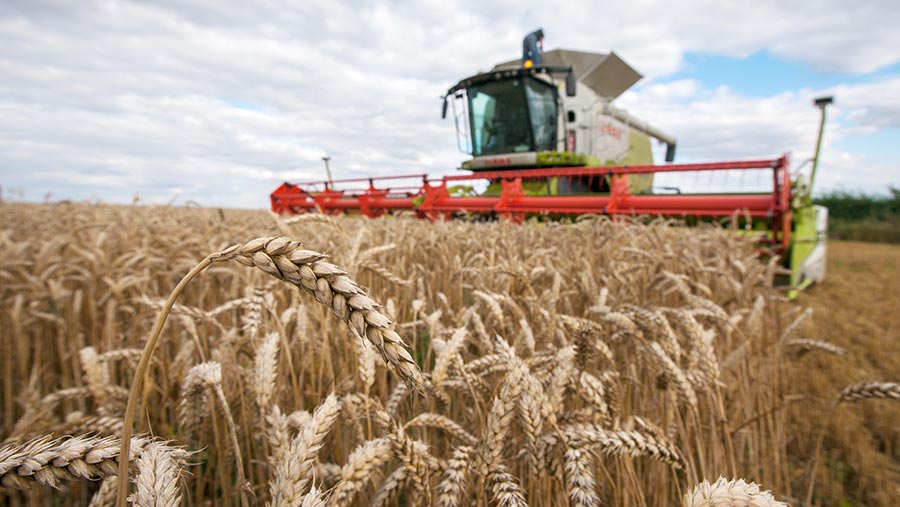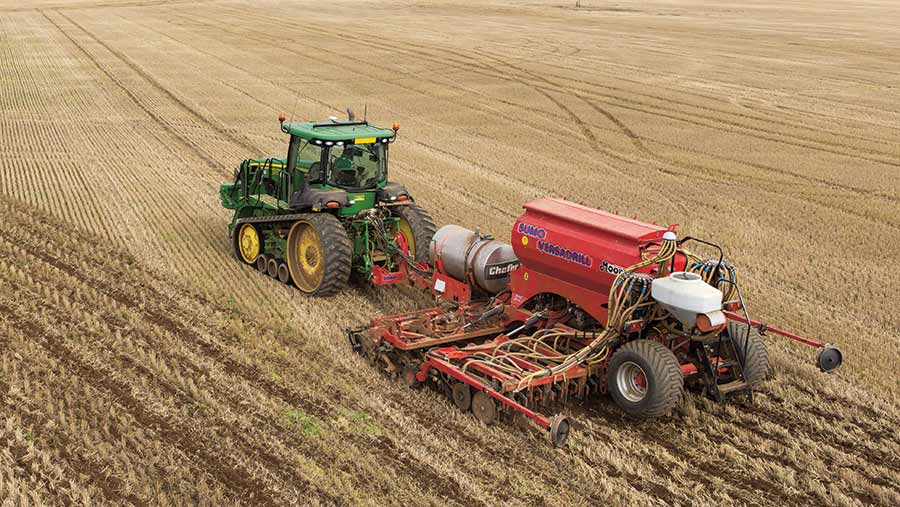Markets analysis: cropping margins for 2020
 © Tim Scrivener
© Tim Scrivener Current market conditions offer a strong incentive to plant wheat for harvest 2020. The gross margin for winter milling wheat is once again one of the strongest at £737/ha, based on a yield of 8.3t/ha and £157/t ex-farm.
However, it is not necessarily an easy choice for growers. If the UK leaves the EU without a deal, prices could face pressure from export taxes and having to price competitively on a world stage.
See also: 6 ways arable farms can reduce business risk
Feed wheat
- Recent rises in the value of wheat (driven by US maize planting challenge), but the global wheat market still looks well supplied.
- If good conditions are experienced in the UK through to harvest, we could see a large crop, with increased exports. Pressure will be added if the Vivergo biofuel plant remains offline into the 2019-20 crop year.
- Prices could be further pressured in a no-deal Brexit when the UK would face a tariff on wheat exports into the EU of €12/t (£10.70/t at current exchange rates). This rate of export tax would apply up to a certain volume known as the tariff rate quota (TRQ), within which any UK wheat exports to the EU are likely to fall.
- The UK will be dependent on pricing competitively against other global exporters.
Milling wheat
- Driven by the underlying feed wheat market and changes in crop quality.
- If the quality of milling wheat for harvest 2019 is good, it is possible premiums will remain relatively stable (currently about £20/t), given the good milling availability seen this season.
- If Vivergo came back online, we may see milling premiums for the north of England rise as mills look to guarantee supplies.
Elsewhere, good margins are seen for premium crops. The margins for winter malting barley and winter milling oats show improvements in returns for harvest 2020.
The winter malting barley gross margin has climbed one place up the league table (see p24) to third at £652/ha, while the margin for winter milling oats has jumped three places, with an estimated margin of £455/ha for harvest 2020.
While these margins are attractive, the open market tends to be more limited. This raises the importance of understanding and supplying the variety and quality your end user requires.
Feed barley
- Planted barley area for 2019 harvest is down slightly year-on-year, but a big crop is still likely if the weather is favourable.
- Domestic demand could absorb some surplus, but there are challenges for exports.
- In the event of a no-deal Brexit, barley will face tariffs to enter the EU from €16/t (£14.28/t)on the first 307,000t of EU imports from any third country origin, not just the UK. Once the quota is filled the tariff rises to €93/t (£83/t). The UK typically exports 1.35m tonnes of barley a year to the EU.
Malting barley
- The picture for malting barley will largely be driven by the underlying feed market and crop quality from harvest 2019.
- Exports are a typically strong market for UK malting barley and there may be challenges with malting barley facing the same tariff schedule as feed barley.
Oats
- The oat market has been well supplied due to a rise in spring oats to fight grassweeds.
- Demand for oats is finite, English mills use winter oats, while Scottish use spring oats.
- If the UK leaves the EU without a trade deal, the oat market surplus will increase. The tariff on oats is set at €89/t (£79/t).
OSR – favourable margin, high costs
In spite of the rising agronomic challenges facing oilseed rape, the crop continues to perform competitively relative to feed wheat.
Purely from a numbers perspective, gross margin data suggests the area of winter oilseed rape should increase. However, we have seen the area planted to the crop fall in recent years due to the variable costs of growing OSR and many crops being lost to flea beetle and poor establishment in dry conditions.
The margin for oilseed rape is estimated to fall from harvest 2019 to harvest 2020 (£626/ha v £606/ha), driven by a reduced price outlook for harvest 2020 and generally higher variable costs over the two years.

© Tim Scrivener
Oilseed rape
- Continental crops have also been faced with many challenges this year.
- Cabbage stem flea beetle will continue to be a challenge for UK growers, particularly given reduced access to certain actives. This will constrain area growth, despite competitive gross margins.
- The upper limit for prices may be capped by crushers and blenders that are able, in some cases, to switch from rapeseed to other, cheaper oilseeds.
- The challenges for oilseed rape make it important to consider what alternative break crops are available, such as some of the niche crops listed in the gross margin comparison.
Lower-cost crop options
The headline margin figures for the likes of linseed and beans are lower, but the cost of growing these crops may make them more attractive options.
This is especially so where access to working capital may be tight and the future of support payments questionable.
Looking at the return on variable costs (the pound of gross revenue for each pound of variable cost), spring linseed, winter feed beans and feed wheat all have a good return on variable cost relative to their headline
gross margin.
Where access to capital becomes tighter, crops like these could have an increasing importance in the rotation.
The return on variable cost for malting barley and human consumption spring beans is also favourable.
Spring and winter malting barley have a return on variable cost of £2.72/ha and £2.63/ha, respectively, while spring beans have a return of £2.51/ha. As mentioned previously though, these markets come with an associated risk of meeting specification if these are unfamiliar crops to growers.

© Tim Scrivener
Linseed
- The linseed market is closely linked to the oilseed rape market and movements in oilseed rape will move the base price for linseed.
- The ban of diquat used as a desiccant on linseed could pose some challenges, although alternative desiccants are being explored.
Field beans
- Prices of beans have been good over the past year, following challenging yields during harvest 2018. This picture for prices looks set to continue for 2019-20.
- The export market for human consumption remains good, with North Africa a key home for UK human consumption beans.
- The UK will be able to export human consumption beans into most existing, non-EU homes at the same rate as EU nations, with World Trade Organization Most Favoured Nation status.
As well as the headline figures, it is important to consider the role some crops may play in the wider rotation, for example, the value to a following crop of nitrogen fixed by field beans and soya beans.
Soya beans
- One of the more niche markets and a relatively little-known crop in the UK.
- Prices track at a premium to imported “any origin” soya beans.
- The gross margins for soya beans are fairly favourable, but this relies on an end market being available. With the more niche crops such as this, it is more important to grow with a guaranteed end market.
With some of the smaller crops in this analysis (including soya beans, which have a particularly attractive margin), it is important to consider the relative demand for the product. The margin of a crop is only as good as your ability to produce and sell it.
Assumptions behind 2020 gross margins
The gross margins show the patterns expected in future cropping, rather than identifying which crop is the most profitable on any particular farm. The margins were collated using the most accurate information available up to 17 June 2019.
The volatile grain market means the margins AHDB has calculated are subject to change.
Later in the season an updated set of spring crop gross margins will be produced to further identify the patterns which might be seen in cropping for harvest 2020.
There are a number of assumptions behind the gross margins. One of the main ones relates to Brexit – a lot could change between now and 31 October 2019.
However, it has been assumed that the UK is due to leave the EU on 31 October and that some form of deal will be reached, so that trade will continue similar to how it presently does.
Should the UK leave the EU without a deal, there will be important ramifications for grain markets. These are covered in the individual crop market snapshots.
Other select assumptions:
- Gross margins do not include the value of straw
- Oilseed rape, linseed and soya bean margins do not include oil bonuses
|
Predicted gross margins harvests 2019 and 2020 |
||||||
|
Crop |
Harvest 2019 Gross margin/ha |
Yield (t/ha) |
Budgeted ex-farm price for 2020/t |
Harvest 2020 gross margin/ha |
Rank |
Change on 2019 ranking |
|
Winter milling wheat |
£697 |
8.3 |
£157 |
£737 |
1 |
– |
|
Winter feed wheat |
£631 |
8.3 |
£147 |
£677 |
2 |
– |
|
Winter malting barley |
£624 |
7.0 |
£150 |
£652 |
3 |
+1 |
|
Winter oilseed rape |
£626 |
3.6 |
£310 |
£606 |
4 |
-1 |
|
Soya beans |
£602 |
2.4 |
£375 |
£595 |
5 |
– |
|
Spring malting barley |
£543 |
5.7 |
£158 |
£566 |
6 |
– |
|
Winter feed barley |
£488 |
7.0 |
£135 |
£519 |
7 |
-1 |
|
Winter oats |
£430 |
5.7 |
£142 |
£455 |
8 |
+3 |
|
Spring beans (human consumption) |
£527 |
3.8 |
£190 |
£434 |
9 |
-2 |
|
Spring oilseed rape |
£433 |
2.4 |
£310 |
£417 |
10 |
-1 |
|
Spring linseed |
£428 |
2.0 |
£350 |
£415 |
11 |
– |
|
Winter feed beans |
£458 |
4.0 |
£170 |
£400 |
12 |
-3 |
|
Spring oats |
£348 |
4.0 |
135 |
£368 |
13 |
– |
|
Source: AHDB, Agro Business Consultants, The Andersons Centre |
||||||
